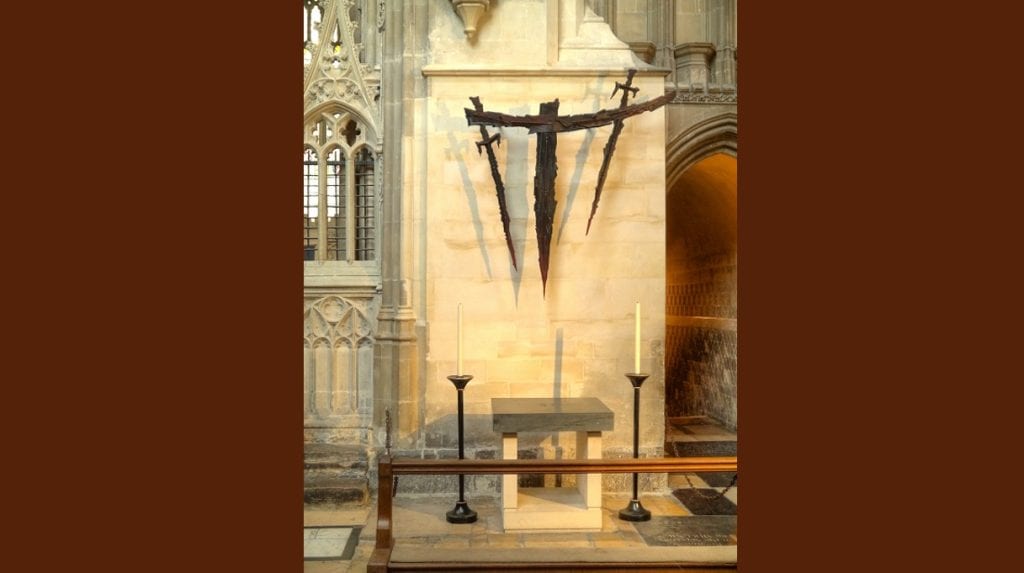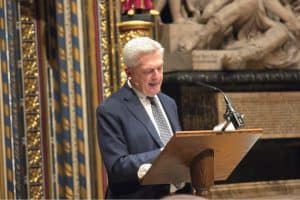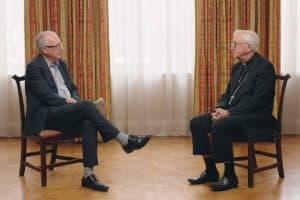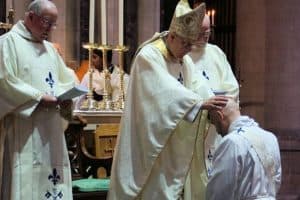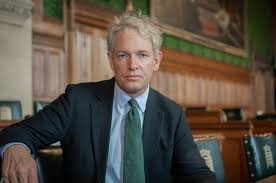By Catherine Pepinster
Once banished by Protestant churches as part of the sweeping changes wrought by the Reformation 500 years ago, indulgences — a Roman Catholic means of ensuring the remission of sins — are now making a comeback in English cathedrals.
And this time, instead of being a sign of division between Roman Catholics and Protestants, their revival in Church of England cathedrals is a symbol of ecumenical friendship.
On Monday, Canterbury Cathedral, mother church of Anglicanism, is to host a Roman Catholic mass celebrated by the papal nuncio, the Pope’s ambassador to the UK.
The mass marks the feast of the translation of Thomas Becket, commemorating the move of the remains of Becket — the Archbishop of Canterbury murdered in the cathedral by knights acting on behalf of King Henry II in 1170 — from the crypt to a new shrine.
Although the feast has been kept in recent times, the shrine was destroyed in 1538 on the orders of Henry VIII and almost all the bodily remains were lost.
However, on Monday, when the nuncio, Archbishop Miguel Maury Buendia, celebrates the mass, organised by the nearby Roman Catholic parish of St Thomas of Canterbury, some of Becket’s bones will be brought from the Catholic church to be displayed during the mass.
Pope Francis designated 2025 a holy or jubilee year, which means Catholics can secure an indulgence — the remission of temporal punishment due to sin — for those who are truly repentant and meet certain conditions, including going to confession and holy communion, praying for the Pope’s intentions, and visiting a pilgrimage site.
The granting and sale of indulgences to Canterbury pilgrims was satirised by Geoffrey Chaucer in his comic masterpiece The Canterbury Tales but continued for another 150 years as part of the culture of medieval pilgrimage, alongside the veneration of relics, across England and continental Europe.
Paying for indulgences was vilified during the Reformation by Martin Luther and although Henry VIII’s henchman, Thomas Cromwell, spent part of his career selling them in Boston, Lincolnshire, he later denounced them as a sign of the corruption of Rome.
His drive against Rome led to the iconoclasm of the English Reformation, with many shrines to saints destroyed, including those at Canterbury.
Nowadays, the focus in the Catholic Church is on spiritual development rather than pilgrims paying to get to heaven more quickly. Elizabeth Forrester, who has been organising the Canterbury Cathedral mass on behalf of the local Catholic parish, said: “This is particularly historic, as there is evidence that there was a papal legate present when Becket’s relics were first translated to the shrine in 1220.”
The earning of indulgences at post-Reformation Canterbury is also a first. “We are able to do this because our parish has been designated a jubilee parish for the holy year,” Ms Forrester said
Canterbury is not the only Church of England cathedral where a visit will lead to an indulgence. In 2022, a 1,353-year-old relic of St Chad, the first bishop of Lichfield, was given to Lichfield Cathedral by the Roman Catholic Cathedral of St Chad in nearby Birmingham, and the shrine was restored almost 500 years after its destruction in 1538.
The move will not, however, deprive Catholics of the chance for an indulgence. “If anyone makes a pilgrimage to Lichfield Cathedral to pray at the relics of St Chad and seeks a jubilee year indulgence, those conditions would be sufficient to gain one,” said Bernard Longley, the Roman Catholic Archbishop of Birmingham.
An icon and a candle stand were placed in the 1980s on the site of Chad’s original shrine, and after it became a focal point of prayer and devotion, the cathedral authorities decided to restore the shrine. The relic has been placed in a commissioned reliquary and was installed during an ecumenical service.
At the time, the Anglican bishop of Lichfield, Michael Ipgrave, who attended the service, said: “The language of relics does not come naturally to many Anglicans, and veneration of them does not usually form part of our spiritual practice. But we do use the language and practice of memory and remembering.”
Visitors to Lichfield have increased since the shrine was restored and the relic of St Chad reinstalled. According to a study by Wolverhampton University in 2013, Lichfield attracted 100,000 visitors; the cathedral’s latest annual report shows that rose to 142,000 in 2024.
Other Anglican cathedrals have seen similar interest in their revival of the veneration of relics.
In 2008, Hereford restored its shrine to St Thomas of Cantilupe, a medieval bishop. Relics of the saint, on loan from the Roman Catholic Jesuit order, are housed for pilgrims to venerate.
At St Albans, named after a saint martyred by Roman occupiers in 250, the tradition of pilgrimage, first recorded 1,700 years ago, has been revived in recent years. St Alban Day was marked in the city on 18 June, bringing thousands, including 200 Orthodox Christians, to join a pilgrimage procession. The re-enactment of Alban’s martyrdom involved 3m-tall carnival puppets representing the saint, Roman centurions, and lions. The day finished at St Albans Cathedral with a procession to the martyr’s shrine, where prayers were said and roses scattered.
The shrine, destroyed during the Reformation in 1539, has been restored and now contains a bone of Alban given by a Roman Catholic church in Germany. It is believed to have been given to a German cleric on pilgrimage before the Reformation.
One shrine that was never destroyed during the Reformation was that of Edward the Confessor at Westminster Abbey. Edward was a saint — canonised in 1161 — but the fact that he was also King of England, 1042-66, seems to have saved him from Henry VIII’s destruction. Every year, the shrine receives 20,000 visitors for tours and communion services. There is a joint evensong with the Roman Catholic Westminster Cathedral at the time of Edward’s feast at the shrine each year, and in 2010, the Archbishop of Canterbury, Rowan Williams, prayed at the shrine with Pope Benedict XVI during his state visit to the UK.
According to Guy Hayward, co-founder of the British Pilgrimage Trust, visitors to pilgrimage sites seem to be particularly attracted to saints’ shrines. “People like anchor points. If you don’t have a shrine, it doesn’t invigorate the journey in the same way. A shrine is a charging point for the soul, a focus for the divine,” he said.

